Overview of Sri Lanka’s Rich Buddhist Heritage
During our many travels across the lush green island of Sri Lanka, we’ve been captivated by architectural marvels that tell the stories of a bygone era. These Stupas, Dagobas, Sculptures, temples and other sacred structures, located amidst forests and rolling hills, hold secrets of a vibrant Buddhist pilgrimage heritage. Let us remind you that many of these pilgrimage sites are UNESCO world heritage sites!!!
Picture this: Cave temples perched high on mountainsides, some of them still echoes the chants of monks. Inside, Buddha statues line the walls, their serene faces illuminated by flickering oil lamps. The ceilings come alive with vivid paintings, narrating stories of Buddhism’s past where time seems to stand still, and the air carries the fragrance of incense and flower offerings.
It doesn’t end there. Sri Lanka’s dagobas or stupas rise like celestial beacons across the land. These ancient structures, built to enshrine sacred relics of Buddha, hold a profound significance. Imagine standing before a massive white dome—the Ruwanwelisaya Stupa in Anuradhapura. Its symmetry and grandeur evoke reverence, even in a non-Buddhist traveler, and as the sun sets, the stupa glows like a pearl against the crimson sky.
And then there’s the vatadage, a circular relic house—an architectural wonder unique to ancient Sri Lanka. Imagine intricate stone carvings, elaborate entrance-ways, and a sense of sanctity that hangs in the air.
This journey isn’t just about marveling at stones. It’s about understanding a culture—a way of life. Sri Lanka’s Buddhist pilgrimage heritage isn’t confined to monuments; it’s woven into the fabric of daily existence. The scent of jasmine garlands at temple entrances, the gentle rustle of saffron robes, and the soft murmur of prayers—all merge into a symphony of spirituality.
Now, let us invite you, with a promise to explore key pilgrimage sites, in the following chapters, that’s will help you plan your Buddhist pilgrimage in the island country of Sri Lanka.
Top Buddhist Pilgrimage Sites in Sri Lanka
We have arranged the Buddhist sites, in the order of the period when they were built or became important.
We have also published an ideal itinerary at the end of this article, which you may follow to complete the Buddhist Route in an optimum number of days. There are a lot more to see at a given place, however we are restricting ourselves to the current pilgrimage sites and in the end at our itinerary, we will include other places of interest.
Mihintale or Mihin-Thale (old name)
It all started here! Mihintale is often called the fountainhead or cradle of Buddhism in Sri Lanka!
Mihintale, situated about 12 KM from Anuradhapura, holds profound significance as the birthplace of Buddhism in Sri Lanka. In the 3rd century BC, the Indian monk Mahinda (Arahat Mahendra), son of Emperor Ashoka of Magadha, met King Devanampiya Tissa atop this hill. Their encounter marked the introduction of Buddhism to the island, shaping its religious and cultural landscape.
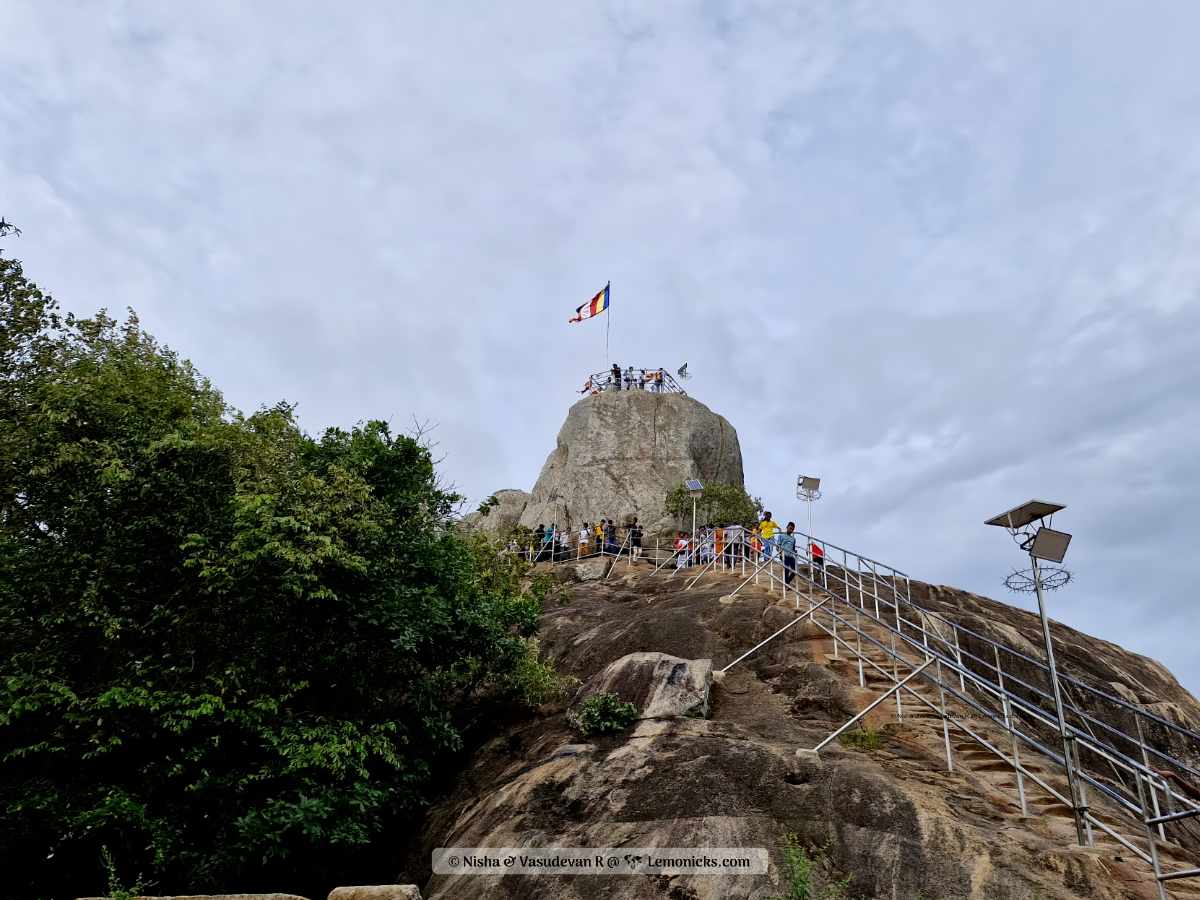
Opening Time : 8:00 A.M. to 5:00 P.M
Time Required: 2 to 3 hours
Ticket Price: LKR 1000.00 foreigners 12 years old and above
Children below 12 and Locals go free.
Contact number: +94 70 555 5213
When Built: 3rd Century BCE (before common era)
Since then, the day when Buddhism arrived in Sri Lanka, is called Poson Poya, or the full moon day of Poson month (in the month of June) and is celebrated in whole of Sri Lanka and is the second biggest festival after Vesak Poya (Buddha Purnima). Nowadays, Buddhist pilgrims flock to Mihintale to pay homage to this historic event. The site features ancient stupas, monastic ruins, and inscriptions that reflect the early Buddhist civilization of Sri Lanka. Pilgrims ascend the stone steps, starting their journey from the foothills to the summit where the revered meeting took place.
The climb from the plateau to top of the rock is more challenging but worth the scenic views of surrounding terrain.
Let us now uncover the pilgrimage sites of Anuradhapura, where history and spirituality have flourished for over 2300 years.
Anuradhapura Rajadhaniya (Anuradhapura Kingdom)
Entire Sacred city of Anuradhapura including Mihintale is a UNESCO World Heritage site.
Anuradhapura is regarded as the first capital of Sri Lanka or Anuradhapura Kingdom or Tambapanni, as it was called then. From middle of 5th century BCE to 11th century CE, that is an unbroken period of almost 1450 years!
It was already the capital city when Buddhism arrived at this emerald island.
Jaya Sri Maha Bodhi Tree (Bo Tree)
At Anuradhapura, the Sri Maha Bodhi tree at Mahamewena Gardens, stands as one of the most sacred symbol for Buddhists. As per wikipedia this Bodhi Tree is believed to be the oldest human planted tree globally, and is over 2,300 years old.
After monk Mahendra (Mihinda Thero) had established the Buddhist order in the island, his sister, that is Emperor Ashoka’s Daughter Sanghamitra (Sanghamitta Therani) brought a sapling from the original Bodhi Tree in Gaya, India, where Lord Buddha got enlightenment. King Tissa planted it at the current site. The purpose of her coming was also to convert the women folks of Anuradhapura.
It is said that even when Anuradhapura stopped being the capital and vegetation covered most places, the Sacred Bo Tree was attended to. The tree is too old, so some of the thicker and older branches are supported using steel braces.
Visit early morning or evening for serenity. Entry is free, but donations are appreciated for maintenance. Experience tranquility and try meditating at the base of the tree.
Opening Time : 6:00 A.M. to 9:00 P.M
Time Required: 30 minutes to 1hour
Ticket Price: Free
When Planted: 3rd Century BCE
Isurumuni Raja Maha Viharaya
Next stop is Isurumuniya Raja Vihara, a tranquil Buddhist temple nestled in Anuradhapura, Sri Lanka. Known for its ancient rock carvings and serene surroundings, this site offers a glimpse into the island’s rich cultural heritage. The temple is open daily from morning till evening.
This place is called Raja Maha Vihara, meaning temple for the royalty, nobles and courtiers. This was built just after the King and his followers were initiated on the tenets of Buddhism. One can say this was the first Buddhist place of worship ever to be built in Sri Lanka.
As you explore, marvel at the intricate carvings depicting scenes from Buddhist folklore and Sri Lankan history. The peaceful pond nearby adds to the serene ambiance, perfect for quiet contemplation. Isurumuniya Raja Vihara invites travelers and Buddhist pilgrims to immerse themselves in its historical and spiritual allure, making it a must-visit in Anuradhapura. Don’t miss the carving on the face of the hill which depicts the Rain God (Varuna) and a horse.
Among the intriguing carvings at Isurumuniya Raja Vihara Museum, there is one depicting two lovers. Legend has it that these carvings represent Prince Saliya, the son of the King, and Ashokamala, a maiden from a humble background. It is said that Prince Saliya renounced his throne for the sake of their love.I guess this is the most photographed carving in the place. It is forbidden to take a selfie with this statue in the background.
Opening Time : 7:00 A.M. to 8:00 P.M
Time Required: 30 minutes to 1hour
Ticket Price: LKR 500
When Built: 3rd Century BCE
Thuparamaya Dagoba
While Isurumuniya was the first place of worship for the royals, Thuparamaya, is the oldest stupa in Sri Lanka located in Anuradhapura. This sacred site, dating back to the 3rd century BCE, holds significant historical and religious importance for Buddhists. Visit during early morning or late afternoon to avoid crowds and enjoy the serene ambiance.
It is said that at Mahinda’s request, King Devanampiya Tissa built Thuparamaya Dagoba and enshrined the right collar-bone of the Buddha.

As you approach, the sight of the majestic stupa with its pristine white dome evokes a sense of reverence. Take a moment to walk around clockwise, a traditional practice for blessings. Thuparamaya Stupa offers travelers and Buddhist pilgrims alike, a chance to connect deeply with Sri Lanka’s ancient Buddhist heritage.
The Stupa is built like a bell. There was a circular roofed pavilion around it called Vatadage. Now only a few pillars can be seen.
Opening Time : 7:00 A.M. to 8:00 P.M
Time Required: 30 minutes to 1hour
Ticket Price: Included in Anuradhapura combo ticket
When Built: 3rd Century BCE
Ruwanweliseya or Mahathupa or the White Stupa
Welcome to Ruwanweliseya, a revered stupa in Anuradhapura, Sri Lanka, embodying serenity and spirituality. Located about 800 meters North of Jaya Sri Maha Bodhi, it was built over 2,000 years ago, its pristine white dome gleams under the tropical sun, beckoning visitors with its historical significance and sacred relics associated with Lord Buddha.
For Buddhist pilgrims and travelers alike, visiting Ruwanweliseya offers a deep cultural and spiritual experience. Begin your journey early morning or late afternoon to avoid crowds and bask in the tranquil atmosphere. Best to coincide your visit with the prayer time, when you will find devotees from all walks of life thronging the passages to pray, light lamps, burn incense and offer flowers. Flowers are almost always Lotus, either in full bloom or as a bud. Each stalk costs less than 50 cents and there are shops just outside Ruwanweliseya Maha Stupa complex!
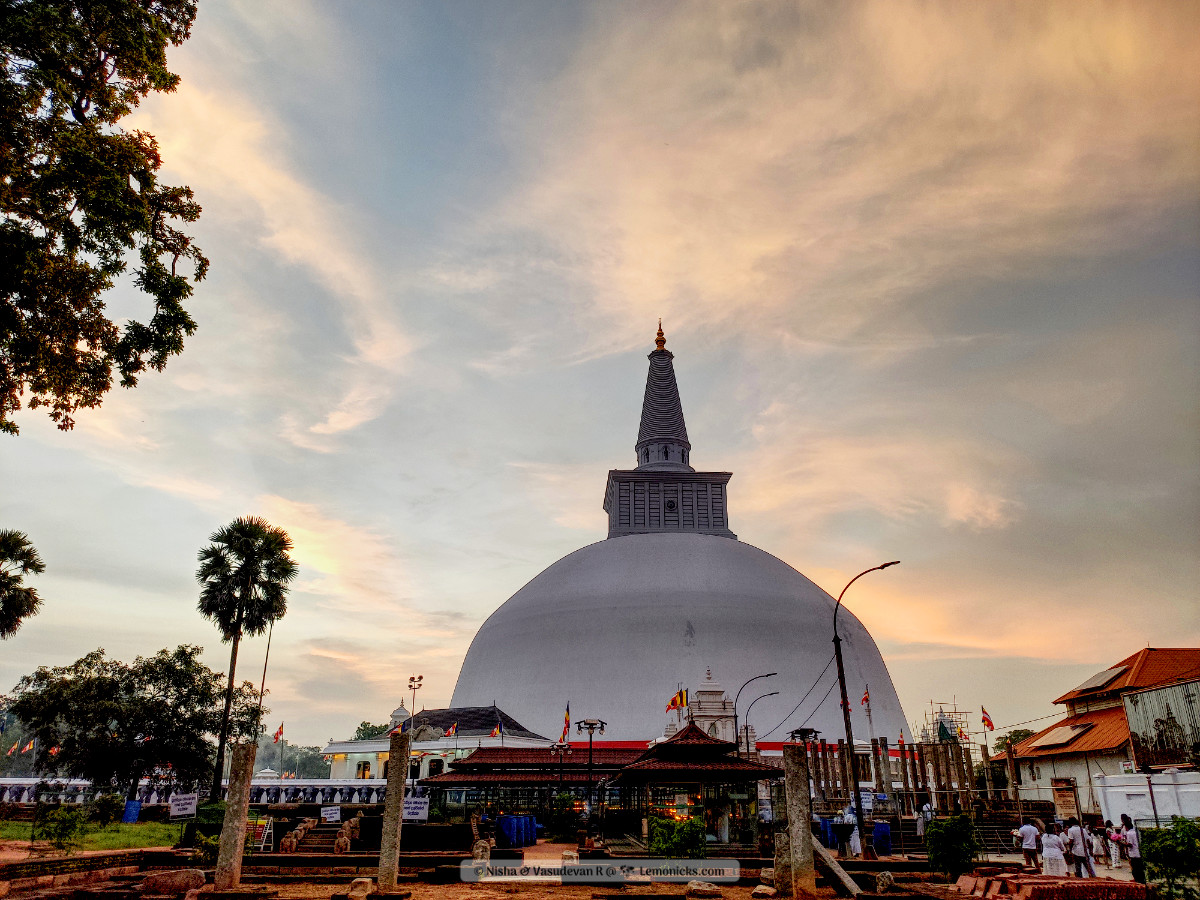
As you approach the stupa, the scent of flowers and incense fills the air, heightening the senses. Circumambulate the stupa clockwise, feeling the ancient bricks beneath your feet, each step connecting you with Sri Lanka’s rich Buddhist heritage. Visiting the image house and other small shrines are a must.
Sit down on the squeaky clean floor and pause to absorb the peaceful ambiance of the surrounding gardens, where you can meditate or reflect on the teachings of Buddha. Whether you seek spiritual enlightenment or cultural exploration, Ruwanweli Mahaseya promises a journey of discovery and tranquility amidst its historical splendor.
This stupa has to its credit, the greatest number of relics enshrined amidst chanting, by several layers of stone and bricks. It was built in 140 BCE by King Dutugemunu (Dutugamunu). Another ancient name for this stupa is Swarnamali Mahaseya
Opening Time : 24 Hours
Time Required: 1 to 2 hours
Ticket Price: Free
When Built: About 140 BCE (before common era)
Also Read: In addition there are several more Stupas like Jetavanaramaya and Abhayagiri each having an interesting story. Click here to read.
Cave and Rock Temples
Sri Lanka’s caves and rock temples are ancient places of worship and practice which adorned with intricate murals and statues, embodying the island’s rich Buddhist heritage. These sacred sites, such as Dambulla Cave Temple and Alu Vihara Rock Temple and others, offer travelers and pilgrims a glimpse into centuries-old religious art and spiritual devotion amidst stunning natural landscapes.
Ridi Viharaya Silver Temple at Kurunegala
The legend, story, and history of Ridi Viharaya are deeply intertwined with Sri Lanka’s rich cultural and religious heritage dating back to 2nd century BCE when Ruwanweliseya was being planned and built, Over 2000 years back. Much of what we know today comes from the beliefs of the people and interpretations found in ancient texts like the Deepavamsa and Mahavamsa. Luckily, I had the privilege of being guided by Marcus first and then again by Nalaka,and have also studied these two books In parts, of course 🙂
Dutugemunu Abhaya, a formidable king in the middle of the 2nd century BCE, remains a central figure in Sri Lankan history. When he had planned to build the Maha Stupa (Ruwanweliseya), he realized that kindoms coffers would not support such an elaborate project.
The story goes, that once, while King Dutugemunu pondered whether to tax his new subjects, the gods above understood his dilemma and ensured that Vissakamma (Vishwakarma), prepared bricks overnight for a stupa. Meanwhile, villagers discovered gold and copper deposits in distant villages, contributing to the stupa’s construction. This, however, was not enough.
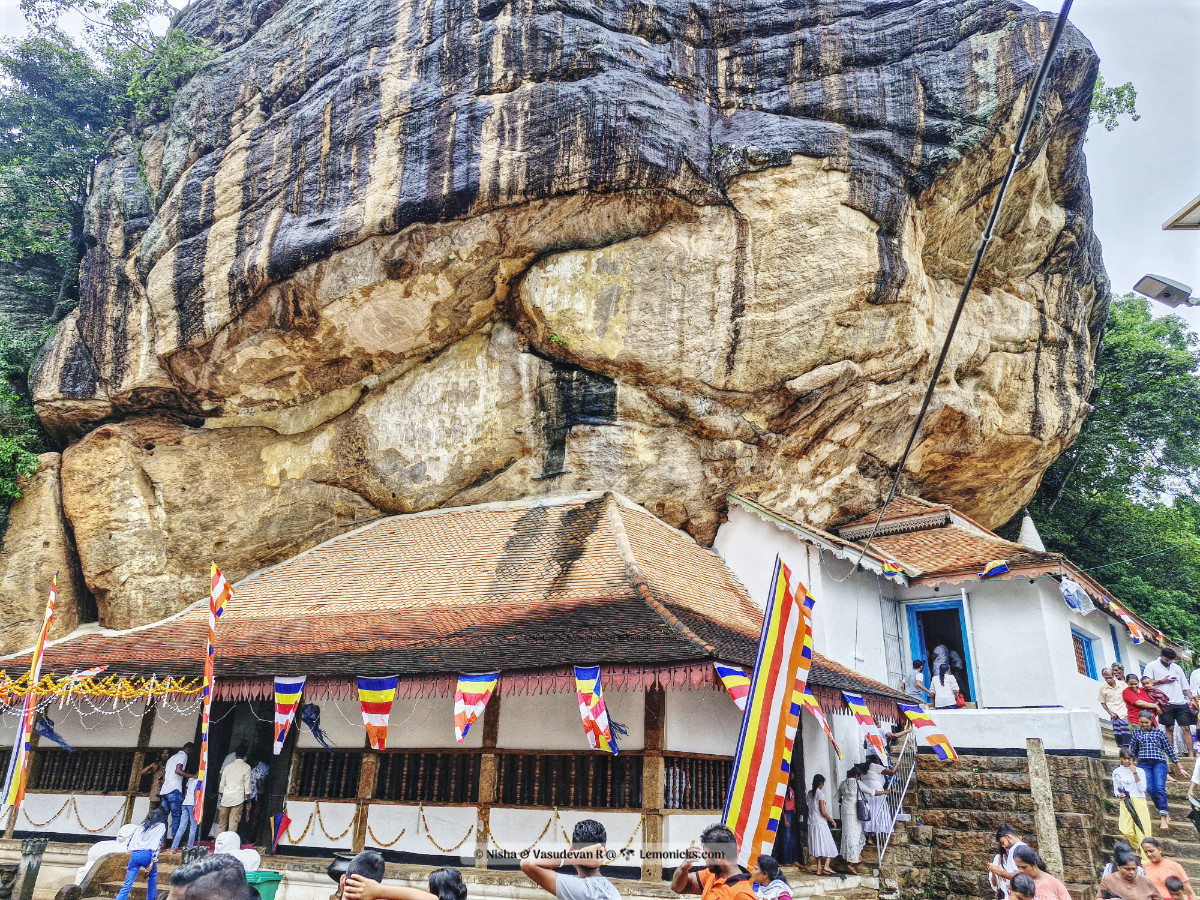
Just then a ginger merchant traveling south of Anuradhapura to Malayadesa encountered a large jackfruit tree near mountains. He offered the fruit to Buddhist monks, and later, kernels to others. One monk revealed a silver cave, leading to the discovery of riches, including silver. This became the Ambatthakola Cave, now part of Ridi Vihara silver Cave temple, located 100 KM from Anuradhapura. These discoveries funded the construction of Mahathupa, though King Dutugemunu did not live to see its completion.
Also Read: Complete Guide to the Fascinating Ridi Viharaya Silver Temple.
Dutugemunu’s legacy extends to numerous monuments, including the Mirisawetiya Dagoba, built to commemorate his victory over King Ellalan. The surrounding grounds of Ridi Viharaya, lush with greenery, echo with the stories of his accomplishments and the religious fervor of the times. His epithet “Abhaya” or “Fearless” reflects his courage and determination in shaping the destiny of ancient Sri Lanka.
Opening Time : 8:00 A.M. to 5:00 P.M
Time Required: 2 hours
Ticket Price: LKR 1000.00 foreigners 12 years old and above
Children below 12 and Locals go free.
Contact telephone: +94 77 50 50 670 or visit https://rideeviharaya.lk
When Built: About 140 BCE (before common era)
Alu Vihara Rock Temple at Matale (Matale Alu Viharaya)
Alu Vihara Rock Temple, is located in the picturesque hills of Matale, Sri Lanka. This ancient cave temple complex holds profound historical and religious significance, dating back to the 3rd century BCE. It is renowned for its impressive rock-cut Buddha statues and vibrant frescoes depicting scenes from the life of Buddha.However its claim to fame is Aluvihare Rock Temple is the historic site where the entire Pāli Canon was first inscribed on ola (palm) leaves..
Visitors may explore the three main caves adorned with intricate murals that vividly portray Buddhist teachings and ancient Sri Lankan artistry. The serene atmosphere inside the caves, coupled with the panoramic views of the surrounding countryside, have to be seen to be believed.
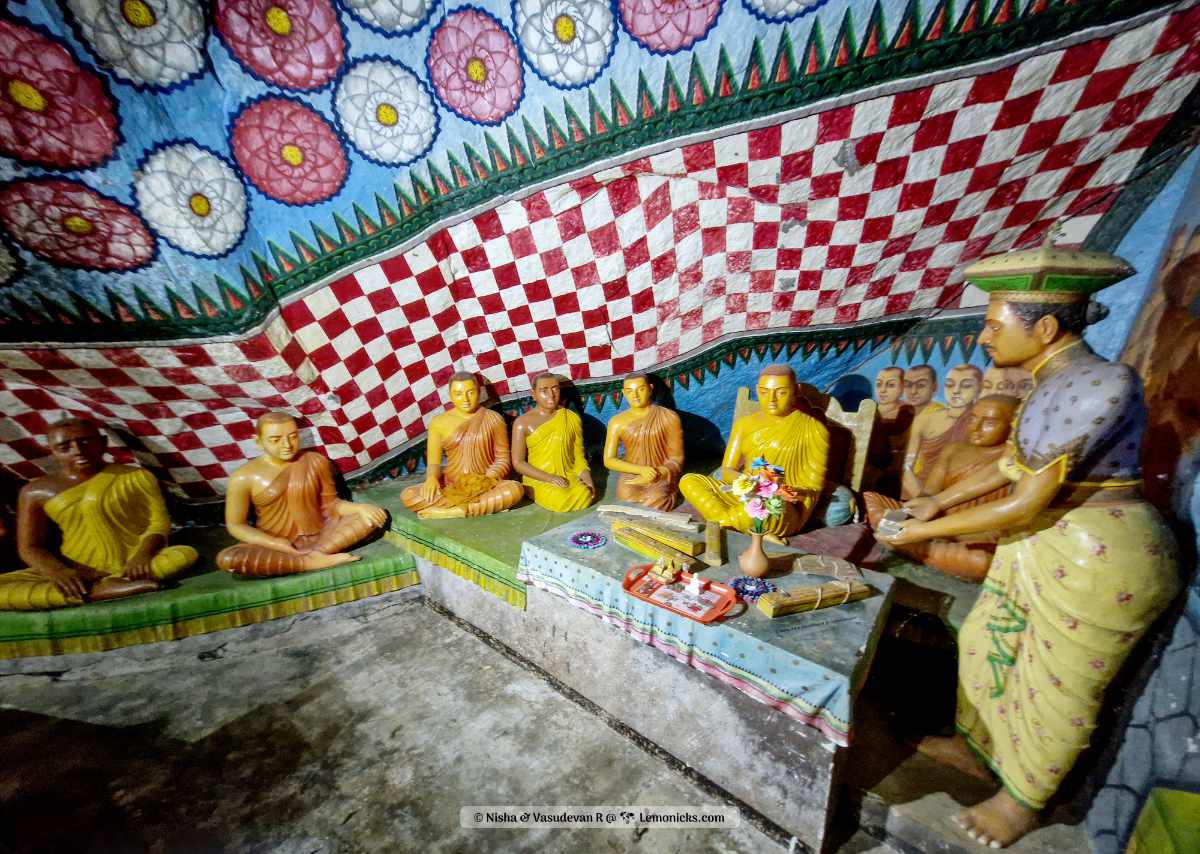
It is believed that Devanampiya Tissa built this Vihara after adopting Buddhism.
In those days the doctrine of Buddhism was learnt and taught orally by repeating and memorizing many times. In the 1st Century BCE, the monks who had to flee because of famine and foreign attack returned when their king Valagamba reclaimed throne. If those monks had been killed then Buddhism would have been lost for ever.
To avoid this scenario in future, the monks decided to write down the Philosophical Doctrines of Buddhism, called Tripitaka, on dry and treated palm leaves (Ola Leaves) by inscribing and dyeing it. If you are lucky the head monk may give you a demonstration of how it is done.
They selected Alu Viharaya as the most suitable location for undertaking this enormous project as it was safe and secure. 500 of the best monks sat down and completed the task in several years.
Dambulla Golden Cave Temple (Rangiri Dambulu Viharaya)
Now to Dambulla Cave Temple, a magnificent UNESCO World Heritage site in Sri Lanka. Nestled atop a hill, this temple complex consists of five caves adorned with ancient Buddhist murals and over 150 statues of Buddha. Rangiri Dambulla Cave Temple is a UNESCO world heritage site.
Also Read: Dambulla Cave Temple
As you ascend, the panoramic view of the surrounding countryside unfolds, offering a glimpse into Sri Lanka’s natural beauty. Inside the caves, the air is cool and fragrant with incense, creating a serene atmosphere conducive to meditation and reflection. Each cave tells a story through intricate paintings and sculptures, depicting scenes from Buddha’s life and teachings.
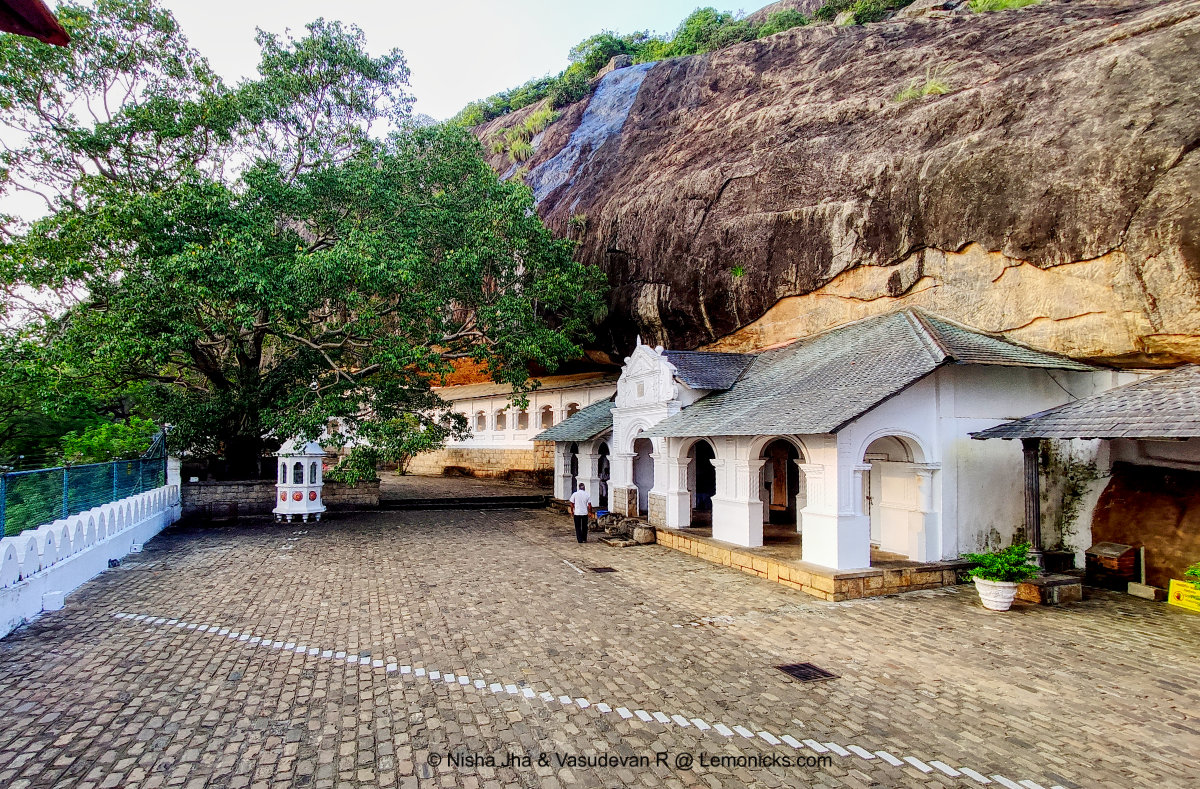
King Valagamba, also known as the great black lion and as Vattagamini Abhaya , started developing the first of the caves as a temple in the 1st century BCE. Since then till as late as 12th Century AD many more caves have been added and renovated. Tourists and pilgrims are allowed in 5 of the biggest caves. Dambulla cave monastery is still functional!
To fully appreciate Dambulla Cave Temple, start your visit early to beat the crowds and witness the morning light illuminate the ancient artwork. Take your time exploring each cave, marveling at the craftsmanship and spiritual devotion embodied in every detail. Whether you’re a traveler seeking cultural enrichment or a Buddhist pilgrim seeking spiritual solace, Dambulla Cave Temple promises an unforgettable journey into Sri Lanka’s rich heritage.
Opening Time : 7:00 A.M. to 7:00 P.M
Time Required: 1 – 2 hours
Ticket Price: LKR 1500.00 foreigners 12 years old and above
Children below 12 and Locals go free.
Contact number: +94 662 283 605
When Built: About 103 BCE (before common era)
Kandy
Welcome to Sri Dalada Maligawa, commonly known as the Kandy Tooth Relic Temple, a sacred site revered by Buddhists worldwide. It is located in the scenic hills of Kandy, Sri Lanka and this temple houses the relic of the Buddha’s tooth, a symbol of spiritual significance and national pride. Sacred City of Kandy is a UNESCO world heritage site.
The journey to Sri Dalada Maligawa begins with a scenic drive through Kandy’s lush landscapes. Open daily from early morning till evening, the temple welcomes visitors with a serene ambiance and a nominal entry fee of approximately Rs. 1000 per person, supporting its upkeep and religious ceremonies.
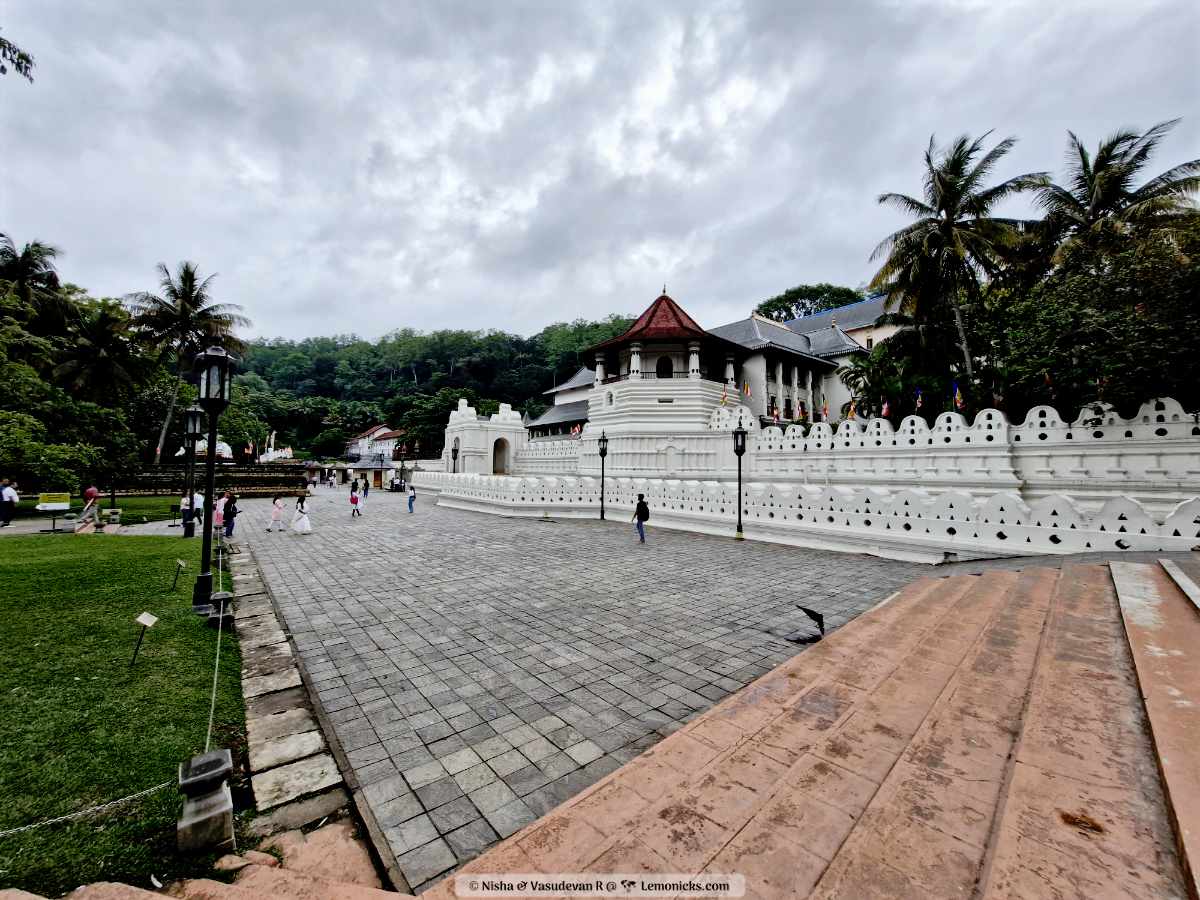
Upon entering the temple complex, you’ll be mesmerized by its grandeur and architectural splendor. The main shrine, where the sacred tooth relic is enshrined, radiates a sense of peace and devotion. Surrounding the shrine are intricate woodcarvings, golden stupas, and colorful murals depicting stories from Buddhist scriptures.
To enhance your visit, attend the daily rituals such as the morning and evening pujas (offerings), where you can witness traditional drumming and chanting by resident monks. Engage with knowledgeable guides who provide insights into the history and cultural significance of the tooth relic. The prayers happen thrice a day and the doors to the room which holds the tooth relic is thrown open for the public. The tooth relic is inside seven nested caskets, which is shaped like a stupa.
Also Read: For more details on the Tooth Relic Temple
Opening Time : 5:30 A.M. to 8:00 P.M
Timings for Special prayers for casket : 5.30 AM, 9.30 AM and 6.30 PM. Always call and find the exact times.
Time Required: 1 hours
Ticket Price: 1500 LKR for Saarc citizens and 2000 LKR for other foreigners.
Contact number: +94 812 234 226
Colombo and Nearby areas
Kelaniya Raja Maha Vihara
Sprawled along the Kelani River in Sri Lanka, Kelaniya Vihara stands as a revered Buddhist temple with a rich history dating back to ancient times.
Legend has it that Lord Buddha himself visited the island 3 times. It is said that during his 3rd visit he had actually visited the site where Kelania temple is situated now and is said to have preached from here. The Kelaniya Stupa enshrines a gem-studded throne where Buddha preached during his second visit to Nagadeepaya, resolving a dispute between two Naga Kings.
After receiving Dhamma teachings, the kings offered the throne to Buddha, who later gifted it to Naga King Maniakkika. In gratitude, King Maniakkika built a Stupa at Kelaniya, where Buddha visited for a third time with 500 Arahats, preaching Dhamma on Vesak Poya Day (A full moon day in the month of May) approximately 2500 years ago.
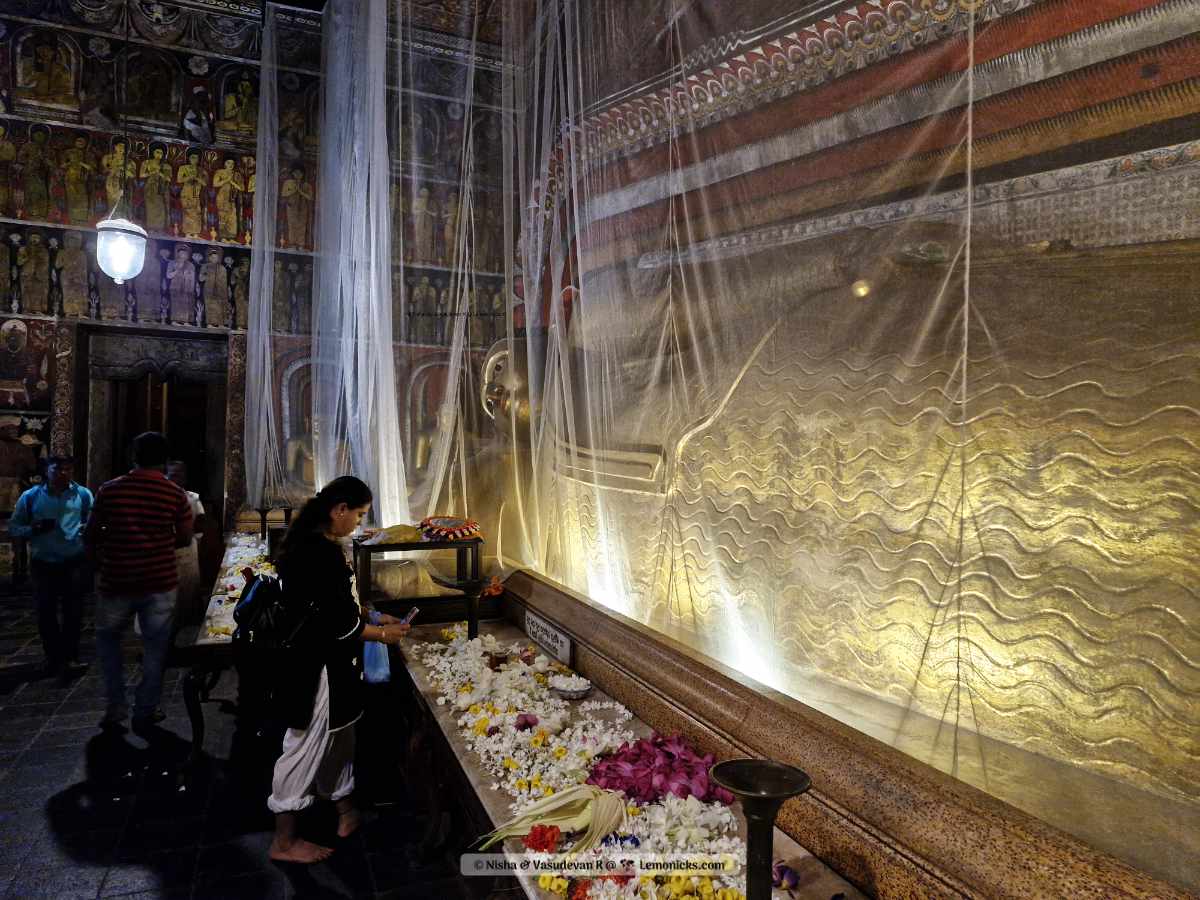
This story also makes Kelaniya Vihara a place of profound spiritual significance for pilgrims and travelers alike.
Kelaniya is also part of another Legend, that of Ramayana. It is said, Ravana’s brother, Vibhishana was crowned here by Lord Rama here after winning over Ravana. There is a small shrine dedicated to Vibheeshana here.
Kelaniya Vihara is renowned for its striking architecture and serene ambiance, offering visitors a glimpse into Sri Lanka’s cultural heritage. The temple complex includes elaborate paintings, intricate carvings, and statues depicting Buddhism stories and teachings, creating a captivating atmosphere of reverence and tranquility. Take a moment to admire the vibrant colors of the murals and the serene beauty of the surrounding gardens.
Whether you seek spiritual enlightenment, cultural immersion, or simply a peaceful retreat by the riverside, Kelaniya Vihara promises a memorable journey into the heart of Sri Lanka’s Buddhist traditions and architectural splendor.
Gangaramaya (Gangarama Temple, Colombo)
Gangaramaya, is a vibrant and bustling Buddhist temple and cultural landmark right in the heart of Colombo, Sri Lanka. This sprawling complex blends traditional architecture with modern influences, making it a must-visit for travelers and Buddhist pilgrims alike.
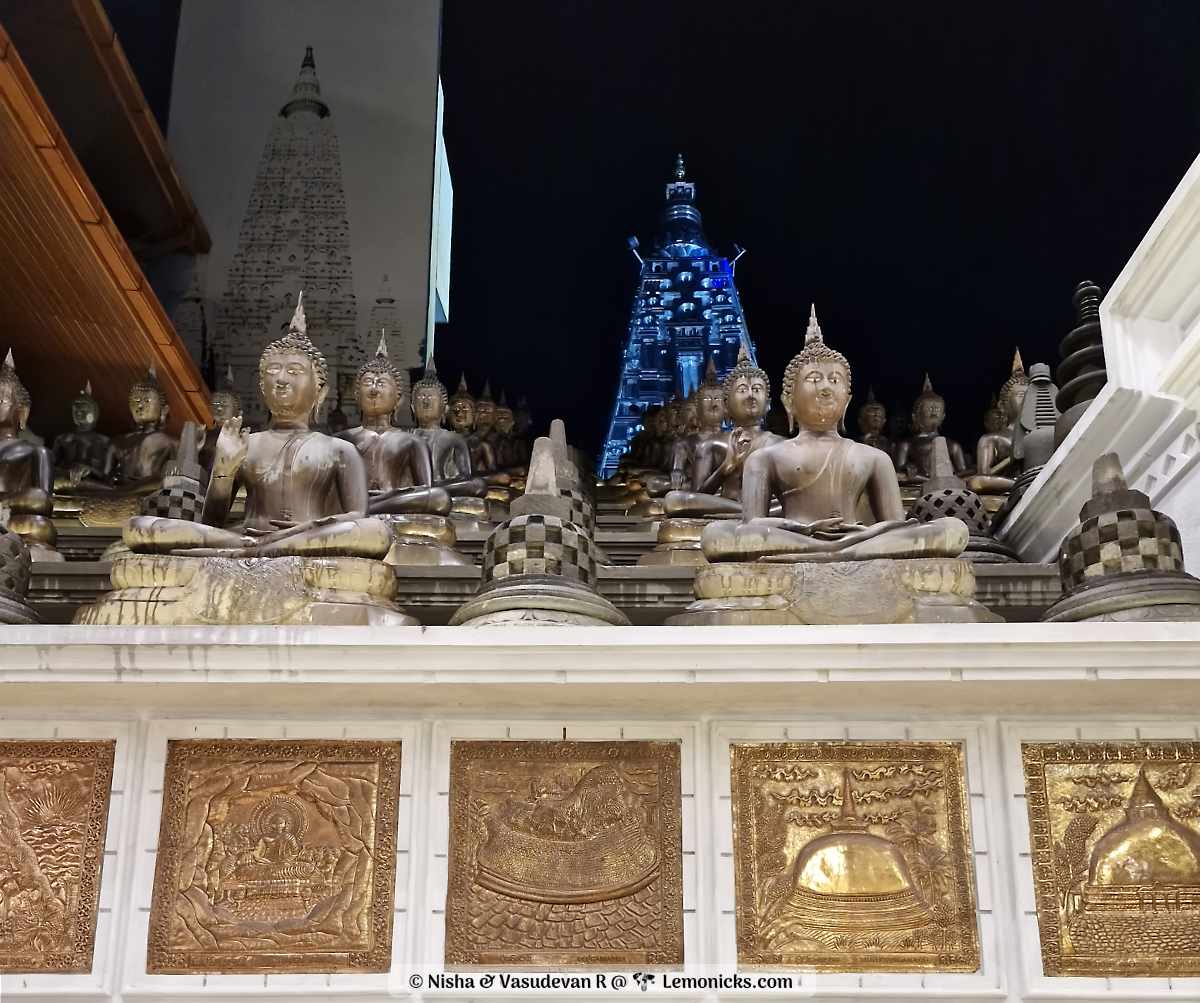
Gangaramaya is renowned for its eclectic mix of Buddhist statues, intricate woodcarvings, and colorful paintings that adorn its halls and shrines. The temple also houses a fascinating museum showcasing artifacts and relics that chronicle Sri Lanka’s religious and cultural heritage.
To avoid crowds, visit during weekdays and engage with friendly monks who offer insights into Buddhist practices and rituals. There is a small artefacts room which has sculptures and items from all over the world. There is another room that contains old Palm Leaf Manuscripts, which you can see if you are lucky. You sort of duck into a small closed door and there you are.
The most important festival of Vesak Poya (Vaishak Purnima) is celebrated with great pomp all over Sri Lanka, but the one in Gangaramaya temple and the area around needs special mention. Vesak in Colombo is a vibrant celebration of Buddha’s birth, enlightenment, and nirvana. The city illuminates, much Diwali in India, with lanterns and pandals. Gangaramaya Temple stands out with its elaborate decorations, spiritual ambiance, and throngs of devotees participating in religious activities, reflecting the deep-rooted Buddhist traditions of Sri Lanka.
Useful Information about Buddhist Pilgrimage Tour in Sri Lanka
Sample Itinerary for Buddhist Pilgrimage Tour in Sri Lanka
- Day 1 – Arrive at Colombo.
- If you arrive in the morning do a Colombo Tour.
- In the afternoon / evening visit Gangaramaya Temple.
- Stay Night at Colombo
- Day 2 – Start early after breakfast at hotel
- Visit Kelaniya Temple. Expect to spend 1 to 1:30 hours
- Drive to Ridi Viharaya Silver Temple. Expect to spend 1 to 2 hours.
- Drive to Anuradhapura
- Visit Jaya Sri Maha Bodhi Tree and Mahastupa Ruwanweliseya
- Stay the night at Anuradhapura
- Day 3 – Start early after breakfast at hotel
- Visit Isurumuni Raja Vihara Temple
- Jethavanaramaya Stupa
- Thuparamaya Stupa
- Abhayagiri
- There are a few more Stupas which may be covered if interested and other places to visit like Samadi Budupilimaya, ruins with beautiful carved Moonstones, Guard statues, twin ponds and others. It is of historical value
- In the afternoon visit Mihintale
- Drive to your hotel in Dambulla or Habarena for stay at night
- Day 4 – Start early after breakfast at hotel
- Visit Sigiriya early in the morning to catch the spectacular sunrise at the top. Although not a Buddhist Pilgrimage site, it is an important tourist site and also a UNESCO world heritage site.
- If interested in wild life and elephants then Minneriya Elephant sanctuary is an interesting place.
- Dambulla Cave Temple
- Night Stay at Dambulla
- Day 5 – Start early after breakfast at hotel
- Alu Viharaya at Matale
- Visit a Spice garden on way to Kandy.
- Maybe a couple of temples in and near Kandy. Read about Things to do in Kandy here.
- Don’t miss the Kandyan Cultural show in the evening.
- Day 6 Early start only if you are planning to visit the first prayer at the Tooth Relic Temple and plan to visit few more temples or tourist sights.
- Visit the Tooth relic temple (Dalada Maligawa) in time for either morning or afternoon prayer
- Drive to Negombo a small town which is close to Colombo airport
- Night stay at Negombo.
- Day 7
- Depending on flight time, you may explore Negombo or move to the airport.
NOTE: There are a lot more things to do on this route itself. You may contact us at [email protected] to draw up your customized itinerary.
Tips for Buddhist Pilgrimage Circuit
- The temples open early or in some places never close. It is best to visit during early morning to beat the crowd and if lucky interact with monks and priests.
- Sri Lanka has good roads and reasonably good public transport. However if you are on a pilgrimage or time is short, book a tour from any travel agent or hire a car with a driver.
- Ask for permission before photographing inside the temple or of the devotees performing prayer etc.
- In Sri Lanka you will find accommodation to suit all pockets. In fact if you are a pilgrim, Ridi Viharaya may offer free stay too. Similarly other monasteries too may offer accommodation. Call them before planning.
- Donations, while not mandatory, are always appreciated.
- If you are not booking a group tour or not hiring a driver, it may be a good to hire a guide. However it is a personal choice.
- Carry water and cover your head as it may become pretty hot in the day time. There are many shops and small eateries all along the roads , you will be never short of food 🙂
- Weekends and holidays may become very crowded. Plan accordingly. In addition full moon days of May and June are festival days and may have even more crowd. However if you are Buddhist Pilgrim, you already know about these 🙂
- Local Sri Lankans may smile at you even if you are stranger. Just greet them and smile back.
Glossary of Terms
- Arahat – An eminent Buddhist Monk (Equivalent of Honourable)
- Bhikkus – plural of Bhikku, in sanskrit – Bhikshu (lit. – mendicant), a Buddhist Monk
- Bhanthe – A term used to address a Buddhist monk
- Thera – An eminent Buddhist Monk (Equivalent of Honourable)
- Jambudwipa – Jambudipa – An ancient Vedic name for what is now subcontinent of India
- Poya – Full moon day
- Bodhi Tree – Sacred Fig tree, Peepul tree, Ficus Religiosa
- Stupa – Thupa – Dagoba – Dageba – It is mostly a sepulchral structure, a commemorative monument. A reliquary, a shrine containing the remains of a holy or sainted person and/or artifacts (relics) associated with them. A bell-shaped, semi-circular or a dome shaped structure raised in the memory of a great Buddhist monk.
- Poya – Purnima or Pournami in India – Full moon day
References and Citations
- Nalaka is an authorized national guide who accompanied us during our entire tour.
- Much of the information on historical incidents and events except our personal experience is also available in Mahavamsa, one of the earliest books, which talks about the history of Sri Lanka.
- Sri Lanka Tourism Board has helped us with gaps in our knowledge.
FAQs (Frequently Asked Questions) on Buddhism Circuit in Sri Lanka
What is the best time to visit Buddhist pilgrimage sites in Sri Lanka?
Sri Lanka gets two rainy seasons. May to July and then again from October to January. That leaves From Jan to May and then from July to October. We have overlapped the months as these months may have lesser rains.
Are there any dress code requirements for visiting these sites?
Sri Lankan Buddhists almost always wear white top to bottom when visiting Temples and Viharas. If that is not possible then at least the top is white. If you are foreigner then this does not apply however, it is always appreciated if you could at least wear light colored shirt or top.
Also note that you would need to cover your shoulders and the dress or shorts should fall below the knee. If that is not possible, buy a couple sarongs and wrap around shoulders and waist.
How long does it typically take to explore each pilgrimage site?
It is very difficult to answer this question as it depends on the interests of the pilgrim or the traveler. Each site would take at least 1 hour. In places where you are required to climb then it could take even 3 hours or more
Is it necessary to hire a guide for the pilgrimage circuit?
It is a personal choice. If you are planning to hire a vehicle then the driver in most cases, can double up as a guide.
Are there any specific etiquettes, customs or rituals visitors should be aware of?
1. You will needs to remove your footwear before entering any place of worship.
2. Ensure you are properly dressed as per the dress code above.
3. You may offer flowers, incense or other items. If in doubt lotus is always preferred.
4. Speak softly or not at all.
5. Ask for permission before taking photos.
6. Never take a photo or selfie with the image of Buddha behind you.
7. Read instructions if any at the entrance and abide by them.
8. Do not talk on phone.
How long does a typical pilgrimage circuit in Sri Lanka take?
We have given a sample itinerary for 7 days. However if you would like to add more places then plan accordingly. You may consult us too , if you want.
What are the 4 main Buddhist pilgrimage Sites in India and Nepal?
In India, there are numerous Buddhist pilgrimage sites. However the 4 most important pilgrimage sites are
1. Lumbini , Place where Buddha was born. (it is in Nepal and not in India)
2. Bodh Gaya, place where Buddha attained Enlightenment
3. Sarnath, Location where Buddha gave his first Sermon,
4. Kushinagar , where Buddha attained Parinirvana (when his soul left his body)
What are the famous Buddhist texts from Sri Lanka?
The earliest book is called Deepavamsa, which means story of the island. (Deepa is from sanskrit word Dweepa which means Island). The second is Mahavamsa, which contains all which are in Deepavamsa but in greater details. These are the most important ones. There are Palmleaf manuscripts written so that Buddha’s teachings may be preserved too.
Are there any meditation retreats available along the circuit?
Yes of course. Here are names of some.
Nilambe Buddhist Meditation Centre: Offers a peaceful environment for lay people to learn and practice Buddhist meditation
Prajapathi Meditation Centre: Provides facilities for meditation practices
Dhamma Kuta Vipassana Meditation Centre: Teaches Vipassana meditation in the tradition of Sayagyi U Ba Khin
Sathipattana Retreat Centre: A place for mindfulness and meditation retreats
What to pack as a Buddhist Pilgrim?
1. Pilgrim’s dress: Comfortable clothes , preferably white or light color.
2. Shawl: To stay warm during cooler evenings and for covering shoulders when visiting temples.
3. Water bottle: To stay hydrated throughout the journey.
4. Small umbrella: For protection against sunlight or rain, depending on the season
5. Camera, Pen and notebook: To record your memories and experiences. Of course noiw-a-days every one carries a mobile phone. This is a personal choice
6. Toiletries: Including personal hygiene items.
7. Hat/Cap: For sun protection.
8. Raincoat: If traveling during the monsoon season if you want to keep both hands are free!
Photograph Copyright
All photographs used in this article belong to the owners of this website www.lemonicks.com unless otherwise specified. Copying or using them without explicit permission is prohibited and will amount to copyright infringement.
P.S.- This article, Buddhist Pilgrimage Circuit Sites in Sri Lanka belongs to Le Monde, the Poetic Travels, one of the top Indian Travel Blogs, published by the traveling couple bloggers, Nisha & Vasudevan. Reproduction without explicit permission is prohibited. If you are viewing this on another website other than the RSS feed reader or www.lemonicks.com itself, then that website is guilty of stealing our content. Kindly do us a favour by letting us know via Contact Us. Thank you
Author – Vasudevan R
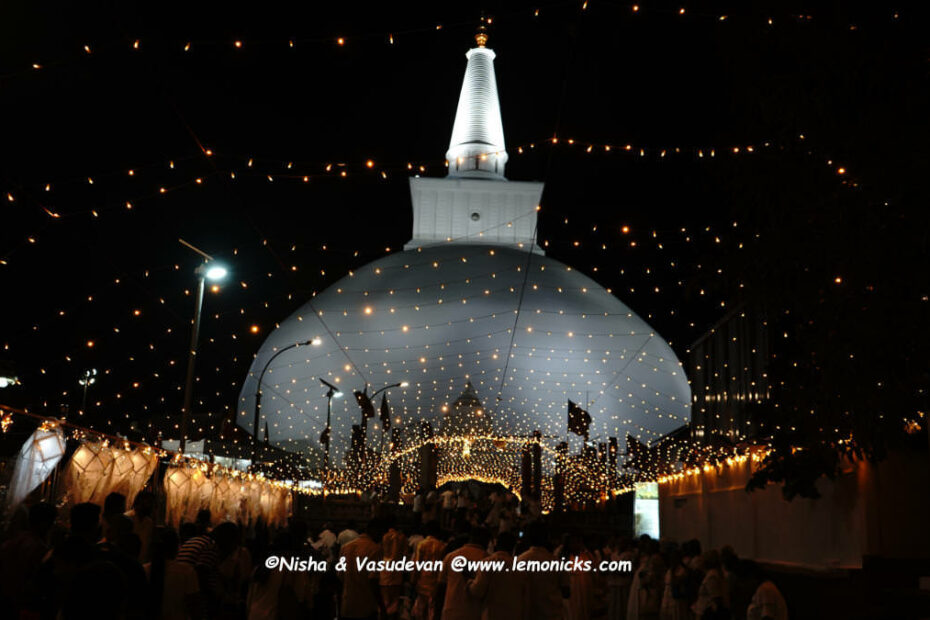

Very well written. This circuit is definitely on my mind.
Thanks for sharing.
Your vivid descriptions transported me to these ancient sites, from the serene Mihintale to the majestic Ruwanwelisaya Stupa in Anuradhapura.
Wow, I didn;t realize that there were so many incredible places of pilgrimage in Sri Lanka. It sounds like such an incredible and rewarding place to visit on your travels.
I’ve been to SriLanka a few years ago and LOVED IT!!! I can’t wait to visit this beautiful country again soon. Oh and the food…DELICIOUS.
I would love to visit all of those sites. I’ve always been fascinated by both history and religion.
Wow, I had no idea the Buddhist places were so fascinating. I’ll add visiting to them to my bucket list.
Wow, that is so interesting, I don’t know a lot about Buddhism but learned new things from your post. Especially, these so beautiful places.
I know so little about buddhist pilgrimages, but these areas look fantastic and it sounds like a wonderful, cultural trip to take. Thank you for sharing.
Sri Lanka sounds like a wonderful place to visit, I had no idea there were so many Buddhist temples.
I am really fascinated by Buddiasm and wow those rock cave temples look incredible, as do all of these places – I can imagine they are real centres of calm.
Thanks for sharing
Laura x